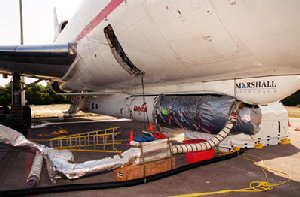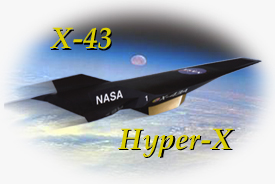This image shows the X-43A hypersonic vehicle. Clicking on this image will show the trajectory the X-43A was suppose to take including air drop from the B-52 plane, ascent by the Hyper-X booster, seperation from the booster and the X-43A free flight.
Click on image for full size
Courtesy of NASA
Hypersonic Vehicle Plummets into Pacific Ocean
News story originally written on June 5, 2001
NASA had three hypersonic vehicles. One of them was being tested on Saturday, June 2, 2000. The vehicle went out of control! NASA figured it was better to blow up the vehicle than to let it get close to land where it might hit something or somebody! So, they blew the vehicle up and the parts fell into the
ocean.
Hypersonic means that the vehicles can go five times faster than the speed of sound. That's over 60 times faster than a car usually drives on an open highway!
Now, NASA has two of these vehicles left. They will be flown after NASA can figure out what went wrong with the first one!
You might also be interested in:

HESSI is the name of NASA's newest satellite built to study the Sun. HESSI stands for High Energy Solar Spectroscopic Imager. Those big words means that HESSI will study solar flares. Solar flares are
...more
HESSI's launch has been delayed. There might be a problem with the Pegasus rocket HESSI was suppose to ride to space on. On June 2nd, another Pegasus rocket went out of control and had to be blown up!
...more
It was another exciting and frustrating year for the space science program. It seemed that every step forward led to one backwards. Either way, NASA led the way to a great century of discovery. Unfortunately,
...more
The Space Shuttle Discovery lifted off from Kennedy Space Center on October 29th at 2:19 p.m. EST. The sky was clear and the weather was great. This was the America's 123rd manned space mission. A huge
...more
Scientists found a satellite orbiting the asteroid, Eugenia. This is the second one ever! A special telescope allows scientists to look through Earth's atmosphere. The first satellite found was Dactyl.
...more
The United States wants Russia to put the service module in orbit! The module is part of the International Space Station. It was supposed to be in space over 2 years ago. Russia just sent supplies to the
...more
A coronal mass ejection (CME) happened on the Sun last month. The material that was thrown out from this explosion passed the ACE spacecraft. ACE measured some exciting things as the CME material passed
...more














